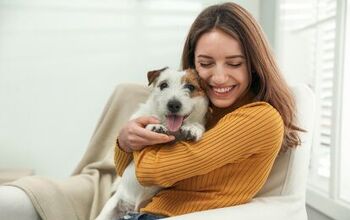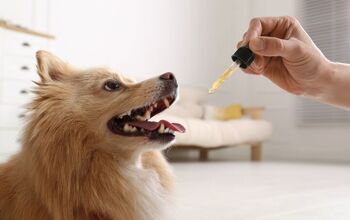Can Counterconditioning Help My Reactive Dog?

Caring for and managing a reactive dog can be incredibly frustrating. Your dog may be a sweet angel at home, but they suddenly evolve into a barking, growling, lunging whirlwind when out in public.
Luckily, there is hope!
Overcoming reactivity is a process that will not happen overnight. However, dog trainers and behaviorists have seen great success with positive reinforcement techniques like counterconditioning.
This article will explore how counterconditioning works, the steps involved in the process, realistic timelines and expectations, and tips for a successful journey toward a calmer, more confident dog. Get started today!
What is Counterconditioning for Dogs?
Let’s start at the beginning—what exactly is counterconditioning, and why is it recommended for managing and treating reactive dogs?
Counterconditioning is a behavioral modification technique that focuses on changing your dog’s emotional response to a specific stimulus.
For example, some dogs feel fear and anxiety at the sight of another dog. This could be due to a lack of socialization, meaning they weren’t taught that other dogs can be friendly. It could also be a reaction to a past trauma, like having been attacked by another dog. In these situations, counterconditioning can be used to teach your dog that the sight of another dog leads to a positive experience.
Why is this an effective approach for addressing reactivity? Reactivity, by definition, is an overreaction to a trigger. While this is often associated with fear or anxiety, some reactive dogs become overly excited. An overexcited dog may jump all over strangers not because they are trying to cause harm but because they are so excited to see them that they can’t control their response.
If you have identified your dog’s triggers, you can use this training approach to teach them to respond in a new (and better) way.
What Can Counterconditioning Be Used to Treat?
Reactivity isn’t the only behavioral condition that can be treated with counterconditioning. This technique can be used to address a wide spectrum of situations in which a pet may be responding to a situation or trigger in an unwanted way.
Some situations where it is commonly recommended include helping dogs overcome specific fears or phobias as well as managing or overcoming behaviors related to obsessive-compulsive disorder.
Common fears that may be addressed with counterconditioning include:
- Fear of car rides
- Anxiety when visiting the vet
- Noises (fireworks, thunder)
- Babies (especially the sound of crying)
- Strangers or other dogs in public
- Allowing guests to enter their home
- Physical triggers like cars or bicycles
- Dogs who dislike grooming, like brushing or having their nails trimmed
If you believe this approach may be helpful in your dog’s unique situation, we recommend speaking with a behaviorist.
You can find professionals in your area by browsing the American College of Veterinary Behaviorists website list or the Animal Behavior Consultants Directory by the American Veterinary Society of Animal Behavior.
What is the Difference Between Desensitization and Counterconditioning?
If you came across this article, it is likely that you have been actively searching for solutions for managing or treating reactivity. Many online websites and articles refer to counterconditioning and desensitization, some using the two terms interchangeably. These are both effective ways to address behavior problems, often used together, but they are two different approaches.
Counterconditioning, as we have already discussed, focuses on changing the way your dog reacts to a trigger. This is done by creating a positive association – helping them view the trigger in a more favorable way. For example, a dog that once felt fear when seeing other dogs may learn to see other dogs in a positive light because they learn that the sight of dogs means they will be given a treat. This positive association changes how they respond emotionally.
Desensitization refers to gradual and intentional exposure to a trigger. This is done over time by pushing your dog outside their comfort level, showing them there is no reason to feel fear or anxiety. This is often used with dogs afraid of thunderstorms, introducing the sound of thunder by playing it quietly at home. Over time, you can increase the volume as they get used to it and no longer react to it at lower levels with fear. Eventually, they will reach the point where they can hear thunder outdoors without it triggering anxiety.
The two approaches have a similar end goal: relieving your dog of the negative emotional response to a stimulus. However, they approach this process in slightly different ways.
Can Reactivity Be Trained out of Dogs?
There is no easy answer to whether reactivity in dogs can be treated.
While some dogs respond well to counterconditioning and desensitization, helping them overcome the strong emotions that cause them to overreact, training doesn’t always work. This wide range of responses to training reflects the many different potential “causes” of reactivity, including a lack of socialization, past trauma, insufficient training, or a genetic predisposition.
A dog that struggles with fear-based reactivity due to a previous traumatic event or bad prior experience may be able to work through their fear, as they are shown that not every situation will end in the same way.
Unfortunately, for a dog whose reactivity is genetic, you may be looking at a life of management.
How Long Does It Take to Fix a Dog’s Reactivity?
As we just discussed, not all dog reactivity can be treated. For many dogs, a carefully designed plan using counterconditioning and/or desensitization will help them overcome the strong emotions driving their reactivity.
The time it will take varies considerably. Some dogs will respond well to the training and start to change their behavior in as little as two months. Other dogs may need consistent training for a year before fully addressing the behavior.
Of course, as we already mentioned, some dogs will never completely overcome their reactivity. Training is still helpful in these cases, as it can potentially lessen their response to a trigger or make it easier for you to manage the situation. But the reactivity is still there, and steps need to be taken to keep your dog out of potentially unsafe or triggering situations.
6 Tips for Managing Reactivity in Dogs
One of the biggest things you can do for your dog is learn how to better manage their emotions and reactions. This will be necessary throughout training, even if the training proves to be successful in the end. For other dogs, these skills may be needed throughout the rest of their lives to give them the best quality of life.
Here are a few tips to help you better manage your dog’s reactivity:
Identify Your Dog’s Triggers
When you realize your dog is reactive, the first step you must take is to note what exactly triggers these behaviors. Does your dog become overexcited anytime they see another dog? Do feelings of fear and anxiety come over them each time they encounter a stranger?
I was told to start a journal when we began working through my dog Lucifer’s reactivity. Anytime we had a “bad day” or “challenging experience,” I wrote down everything I could recall about that moment, including what we were doing, where we were, and what was around us. I could identify trends that shed light on his response by comparing the entries.
Don’t forget that not all triggers are visual. Some dogs respond to audible triggers like a dog barking or a car horn.
Knowing what stimuli will potentially send your dog’s emotions into overdrive will allow you to make decisions and take steps to limit or avoid these triggers in the future.
Create a Daily Routine
Dogs thrive on routine. For dogs whose reactivity is based on anxiety or fear, a daily routine reliably tells them what to expect from one moment to the next. This includes feeding them at the same time each day, daily training or exercise times at the same time, and even a bedtime routine, if you have one in your home. Try to stick to this routine as much as possible.
A daily routine doesn’t directly impact their reactivity, but it does help to reduce overall stress and anxiety levels, which can help keep your dog’s emotional state in check.
Keep Your Own Emotions in Check
Our dogs feed off our emotions. If you walk into a situation feeling anxious or stressed out, they will pick up on that, and it can increase their stress levels. Instead, try to keep yourself calm and relaxed.
Don’t yell or raise your voice. Offer corrections in a calm, even tone. If your emotions start to rise, take it as a sign to remove your dog from that situation. This could mean turning around and walking in a different direction, crossing the road to avoid an oncoming trigger, or leaving a park if you notice off-leash dogs running around.
Focus on Positive Reinforcement
Dogs that are stressed or fearful need to build their confidence. This won’t happen through punishment. By punishing their reaction, you are adding to the negative association they already have with the trigger, potentially making the situation worse in the future.
Instead, focus on using reward-based methods that create a positive association for your dog. This is where counterconditioning comes in—associating the trigger with a reward like favorite treats or praise from the person your dog wants to please most: you!
Avoid Potentially Unsafe Environments
Are there specific situations where you know your dog is far more likely to react? Where possible, avoid these environments entirely. Why set your dog up to fail?
If you have a dog that is reactive to other dogs, there is no need to visit the dog park or plan puppy play dates unless it is at a distance as part of a structured training session. Contrary to popular belief, dogs don’t need to be highly social with other dogs to be happy. Is a well-socialized dog the ideal? Of course. However, many dogs simply don’t like having other dogs around, and that’s okay!
Focus on creating positive situations for your dog that allow for physical and mental enrichment while avoiding triggers. For example, if your dog loves being able to run at the dog park but doesn’t do well with other dogs, consider renting a private dog park through an app like Sniffspot.
Contact a Professional
Don’t be ashamed or afraid to ask a professional for help. Your dog's behavior problems do not reflect on you as a bad owner, and no professional will judge you negatively for being willing to put the time into giving your dog a better life.
Even if your budget won’t allow for regular training sessions right now, contact a behaviorist and explain your situation. They may be able to direct you to helpful resources to start working with your dog or even to access financial aid if it’s available.
Final Thoughts: Counterconditioning for Reactive Dogs
Whether you have just noticed your dog starting to exhibit reactive behavior or have been dealing with these extreme responses for a long time, there is no wrong time to start working on your dog’s behavioral problems.
Counterconditioning is a positive reinforcement approach to shifting your dog’s emotional response to a trigger, helping them to respond in a healthier and more acceptable way. While it won’t offer a solution overnight, it is highly effective in many reactive dogs when training is carried out consistently over several months.
Unfortunately, not all reactive dogs can be “fixed” with training. If, after working with a canine behaviorist, your dog is still struggling with their overwhelming emotions, you may need to consider lifetime management. This includes reducing their exposure to triggers and taking steps to avoid putting them in a potentially dangerous situation.
Most importantly, remember that reactive dogs are good dogs, too! They are just struggling with difficult and overwhelming emotions.
Join the PetGuide community. Get the latest pet news and product recommendations by subscribing to our newsletter here.

Britt Kascjak is a proud pet mom, sharing her heart (and her home) with her “pack” which includes her husband John, their 2 dogs – Indiana and Lucifer – and their 2 cats – Pippen and Jinx. She has been active in the animal rescue community for over 15 years, volunteering, fostering and advocating for organizations across Canada and the US. In her free time, she enjoys traveling around the country camping, hiking, and canoeing with her pets.
More by Britt
























